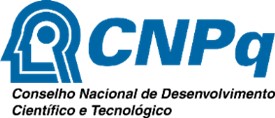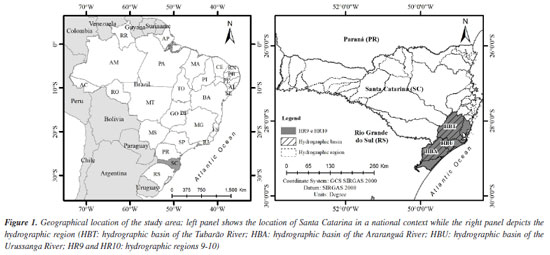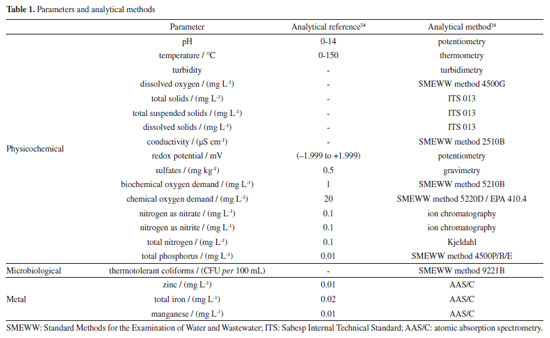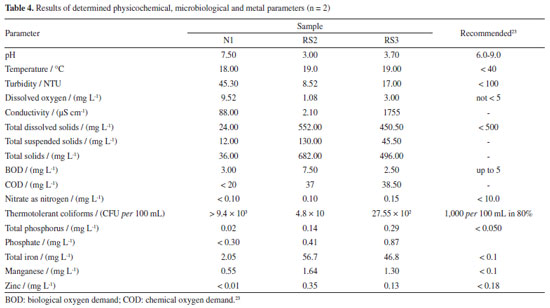Artigo
| Pharmaceutical contamination, water quality assessment and ecotoxicological evaluation of the surface waters of the Sangão River, Santa Catarina, Brazil |
|
Michele D. FreitasI; Samira Leila BaldinII I. Laboratório de Plantas Medicinais (LaPlaM), Programa de Pós-Graduação em Ciências Ambientais, Universidade do Extremo Sul Catarinense (UNESC), 88806-000 Criciúma - SC, Brasil Received: 08/21/2024 *e-mail: amaral@unesc.net The waters of the carboniferous basin located in the South of the Brazilian State of Santa Catarina, which are comprised of the hydrographic basins of the Urussanga, Tubarão and Araranguá Rivers (HBA), are an important hydrological resource. Due to the importance of the Sangão River, we evaluated the quality of its surface waters through detection of pharmaceutical contaminants and evaluation of physicochemical parameters. Six contaminants were detected in analyzed samples, including caffeine in all samples. Notable parameters included pH (observed range between 3-7.5), dissolved oxygen (1.08-9.52 mg mL-1), total iron (2.05-56.7 mg L-1), conductivity (2.10-1755 µS cm-1), biochemical oxygen demand (2.5-7.5 mg mL-1), phosphorus (0.02-0.29 mg L-1) and thermotolerant coliforms (values > 9.4 × 103 colony-forming unit (CFU) per 100 mL). We determined the water quality index (WQI) of the samples and performed an acute ecotoxicological study using zebrafish embryos. The results of the WQI revealed that although the source (N1) was classified as regular, samples collected upstream (RS2) and downstream (RS3) of the wastewater treatment plant (WWTP) were considered bad. In the ecotoxicological analysis, all embryos tested in groups RS2 and RS3 were not viable 24 h post-fertilization, although those collected at source survived the experiment. Collectively, our results inform the conclusion that the surface water quality of the Sangão River is impacted from its source onwards, and that remedial strategies are warranted. INTRODUCTION Water is a renewable commodity and essential to life. The hydrological cycle describes the interplay of surface water, groundwater and atmospheric water, while global and climatic forces influence the variability of precipitation and evaporation. These factors, among others, define the pattern of runoff and availability of water on the planet. The continuous and permanent interactions between these components are the fundamental characteristics of the water cycle, and ensure the sustainability of biodiversity in ecosystems, communities and populations.1,2 Intensification of human activities has compromised both availability and degree of contamination of water resources.3 The presence of emerging contaminants in the environment is a growing global concern, in light of the increasing diversity of chemical compounds available to consumers.4 The increased use of these agents has promoted their spread throughout various compartments of ecosystems, yet few studies address their analysis and their influence on the health of the multiple species exposed to them.5 Among the various compounds classified as emerging contaminants, drugs account for a significant proportion, although acute exposures are less obvious than with other contaminants. However, their subtle long-term effects cannot be ignored.6 Several routes can be noted as entry points of pharmaceutical contaminants into environmental compartments. These include inappropriate use and inadequate disposal of drugs, direct sewage (human or veterinary) and wastewater discharge into water bodies.7,8 For the most part, conventional wastewater treatment plants (WWTPs) do not effectively remove emerging contaminants, and thus can contribute to their persistence in the environment.9 Brazil is one of the richest countries with respect to hydric resources, with about 12% of the renewable water of the planet.10 However, these resources are unevenly distributed across the country.11 The State of Santa Catarina (SC) has 23 main hydrographic basins, which can be divided into inland slopes (Paraná watershed and Uruguai watershed) and Atlantic (Southeast watershed). State law No. 10.949 of November 9th, 1998,12 with the purpose of planning, administering and managing the hydric resources of the State of Santa Catarina, established ten hydrographic regions.13,14 The carboniferous basin, situated in the south of Santa Catarina, includes the hydrographic basins of the Tubarão River (hydrographic region No. 9 - south of Santa Catarina), the Urussanga River and the Araranguá River (hydrographic region No. 10 - extreme south of Santa Catarina) (Figure 1). Of these, the hydrographic basin of the Araranguá river (HBA) is located between latitudes 28º40' S and 29º10' S and longitudes of 49º20' W to 50º00' W.13 Water quality of this basin is compromised in some sections, because of various activities including agriculture, disorderly growth, deforestation of slopes and riparian forests, industrial and domestic effluents and mining.13,15
Mineral coal extraction in the carboniferous region from 1970 to 1990 promoted the socioeconomic expansion of the area, but in return triggered profound environmental impacts on approximately two-thirds of the hydric resources in this region.16 In particular, rivers were contaminated by acid mine drainage (AMD) waters, characterized by low pH values (2-4), and with high concentrations of sulfates and dissolved metals.17 Among the rivers of the HBA compromised by coal extraction, the Sangão River stands out, considered one of the fifteen main rivers of the basin and containing the largest number of coal processing centers.18,19 Besides contamination from coal processing, the Sangão River receives high loads of urban waste, industrial pollution and domestic sewage from the municipality of Criciúma.17 Considering the ongoing impact of human activity on the waters of the Sangão River, and the lack of other published work on the topic, the objectives of this work were firstly, to identify any pharmaceutical contaminants in the waters of the Sangão River, and secondly, to evaluate its surface water quality, using a combination of physicochemical parameters, the water quality index (WQI) and through an acute ecotoxicological study using zebrafish embryos.
EXPERIMENTAL Study area and sample collection The study was performed in the Sangão River. This river has its source in the municipality of Siderópolis, SC, and its mouth at the Mãe Luzia River, on the territorial boundary between the municipalities of Maracajá, SC, and Forquilhinha, SC (Figure 2a). It is considered one of the fifteen most important rivers of the HBA water system, crossing a large area of the municipality of Criciúma and being the destination for effluent discharge after treatment in the wastewater treatment plant (WWTP).19
The surface water samples were collected at three different points, in the municipalities of Siderópolis (collection area 1 - AC1, containing the source point) and Criciúma (collection area 2 - AC2, the location of the second and third collection points) (Figure 2b). The three sampling points were the source (N1), the Sangão River 100 m upstream of the sewage treatment plant (STP) (RS2) and the Sangão River 100 m downstream of the STP (RS3). The distance of 100 m was determined according to the procedure adopted by the institution contracted to analyze the samples. Sample collection was carried out in July 2017. Samples were collected in triplicate for each point described in the study. The collection procedure followed the Brazilian Association of Technical Standards ABNT-NBR 9898/1987.20 The samples were collected manually, at a depth between 15 and 30 cm. A total of 5 L of surface water was collected for each sample. All samples were subjected to physiochemical, microbiological, water quality and ecotoxicological analyses using zebrafish embryos. Sample N1 provided a white data point. Determination of pharmaceutical contamination in surface waters Sample preparation and analysis Glassware sterilization and sample preparation were performed using a protocol adapted from the literature.21 Sample preparation followed the methodology described by Arsand,22 a qualitative methodology validated for 301 compounds (pharmaceuticals and pesticides), at three concentration levels (1.0; 0.1 and 0.01 µg L-1). Briefly, for solid phase extraction (SPE), a Strata-X™ polymeric reversed phase cartridge (33 µm, 200 mg, 6 mL) was used for sample preconcentration and clean-up. Surface water samples were subjected to a vacuum filtration process with nitrocellulose filters at the following, successive porosities: 9, 5, 1.2 and 0.45 µm. Cartridges were conditioned with 3 mL of methanol containing 50 mmol L-1 of acetic acid (HAc), followed by 3 mL of acetone containing 50 mmol L-1 HAc and finally 3 mL of water containing 5% methanol, at a flow rate of approximately 5 mL min-1. Extraction was performed under vacuum, and a sample volume of 250 mL was loaded at a flow rate of approximately 10 mL min-1. After the percolation step, the cartridge was dried for 5 min in vacuo (approx. 16 mmHg). Elution proceeded with 6 mL of MeOH containing 50 mM HAc, followed by 6 mL of acetone containing 50 mM HAc. The final extract was reduced to 100-200 µL using a water bath at 42 ºC under a gentle stream of nitrogen. The extract was reconstituted with water:acetonitrile (95:5) to a final volume of 1.0 mL. Aliquots of 5.0 µL were injected into the liquid chromatography-quadrupole time-of-flight mass spectrometry (LC-QTOF-MS) system. For instrumental analysis, an ultra-high performance liquid chromatograph (UHPLC, Nexera X2, Shimadzu) coupled to a mass spectrometer (MS, Impact II Bruker, Bruker Corporation) was used to analyze the samples. Samples were analyzed by electrospray ionization (ESI) in positive mode. The m/z range established for data acquisition ranged from 50 to 1000 Da. Data analysis was performed using Target Analysis™ and Compass Data Analysis™ (Bruker) software. A total of 113 compounds were screened for encompassing both human and veterinary drugs, with the results indicating the presence or absence of these compounds, with a limit of detection (LOD) of 0.01 µg L-1. Evaluation of physicochemical, microbiological and metal composition Determinations of physicochemical, microbiological and metal parameters of the samples were performed as listed under National Resolution No. 357/2005,23 which regulates the conditions, parameters, standards and directives for the management of effluent releases into water bodies. Standards selected were those specified for class II rivers. The tests were carried out at the Science and Technology Park of the Universidade do Extremo Sul Catarinense. Determinations on each sample were performed in duplicate, using the analytical methods shown in Table 1.
Evaluation of the water quality index (WQI) Monitoring water quality is essential to identify the level of degradation of the water body. The WQI is a mathematical tool that integrates several parameters and transforms them into an expression of the water quality index. To evaluate and characterize the WQI of the Sangão River, the National Sanitation Foundation Water Quality Index (WQI-NSF) was determined. This index was developed by the National Sanitation Foundation (NSF) of the United States.23 It is calculated from the results of nine physicochemical and microbiological parameters. For each parameter, average curves of the variation of the water quality were drawn as a function of their respective concentrations and a weight was assigned according to its relative importance in the WQI calculation. WQIData software25 was used to determine the results. Raw water quality, indicated by the WQI, varies on a scale of 0 to 100.25,26 The classification is shown in Table 2.
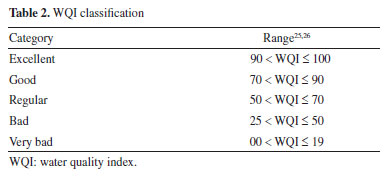
Acute ecotoxicological study with zebrafish embryos Ecotoxicological tests were based on the fish embryo toxicity (FET) protocol,27 which consists of four types of observation to indicate embryo lethality 24-96 h post-fertilization. The zebrafish embryos were divided into four groups containing twenty embryos each. All groups were exposed to 1 mL of each tested sample, with the control group exposed to reverse osmosis-treated water and the others divided into three groups, based on exposure to either source water (N1), Sangão River water upstream of the STP (RS2) or Sangão River water downstream of the STP (RS3). The data were quantified and expressed as absolute values of survival and mortality after 24 h. For this test, 80 embryos were divided into the 4 experimental groups; therefore 20 animals were used per group (n = 20). All protocols were conducted in accordance with the National Institute of Health Guide for Care and Use of Laboratory Animals and approved by the Ethics Committee of the University of southern Santa Catarina (UNESC), protocol number 081/2017-1.
RESULTS AND DISCUSSION Detection of pharmaceutical contaminants Of the 301 compounds detectable via SPE-LC-Q-TOF-MS, 118 were validated and their presence in the samples was evaluated. Table 3 presents the average results of the samples analyzed in triplicate, and indicate the presence or absence of these contaminants in each of the analyzed samples. The methodology evaluated the presence of these compounds at three concentration levels: 0.01; 0.1 and 1.0 µg L-1. As the analysis was quantitative, the results are expressed as a concentration range, with only six of 118 compounds identified, all at levels lower than 0.01 µg L-1.
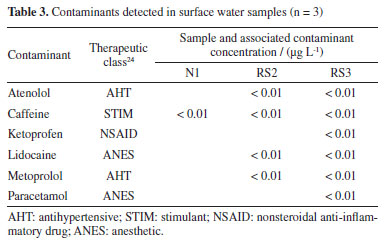
Among various therapeutic classes investigated, six individual contaminants were found, belonging to antihypertensive (2), stimulant (1), nonsteroidal anti-inflammatory (2) and anesthetic (1) classes. One of the main routes for pharmaceutical contaminants to enter the environment is due to the direct discharge of domestic sewage into water bodies. Although the source of the river suffers from anthropic actions, mainly through cattle raising activities, the degree of contamination was lower when compared to the Sangão River extension cutting through the urban areas of Siderópolis and Criciúma. These cities had their economic and population growth linked mainly to coal exploration. And this unplanned growth caused negative impacts on the quality of the Sangão River, as it is affected by the release of domestic sewage, mainly from the city of Criciúma. Also, the absence of further contaminants in the spring may reflect their presence in quantities below the detection limits of the equipment, which was 0.01 µg L-1. Caffeine was the only substance found in all analyzed samples, also being the only one detected in the source sample. Although a potential pharmaceutical contaminant, it is more likely that the widespread consumption of products containing caffeine in foods and beverages explains its wide occurrence. This substance is commonly used as an indicator of anthropogenic activity in natural environments, as its presence is directly related to the entry of untreated domestic sewage into environmental compartments.9 The local anesthetic lidocaine was detected in RS2 and RS3 samples. This aligns with studies28 conducted in China, where the presence of lidocaine was noted in all surface water samples analyzed from three rivers, at an average concentration of 0.098 µg L-1. Similarly, in Greece, lidocaine was detected in seawater with a high detection frequency (> 90%) and in a maximum concentration of up to 0.0128 µg L-1.29 As 90% of the consumed dose of lidocaine is metabolized, with only 10% released unchanged into the environment,30 the presence of this substance in the analyzed samples may be related to the improper disposal of drugs into the sewage system. Studies conducted by Mandaric et al.31 found that anti-inflammatory drugs were the most frequently detected compounds in treated and untreated wastewater in Spain, assigning this contamination to the ease of access to this therapeutic class, as, for the most part, these are commercialized without medical prescription and widely used in self-medication practices. In this work, the NSAID ketoprofen, along with the related drug paracetamol, was detected in RS3 samples. The presence and persistence of ketoprofen in wastewater after WWTP treatment has been previously described.32 Similarly, paracetamol is a drug widely used for its analgesic and antipyretic properties. The liver, and to a lesser extent, kidney and intestine, are the main organs involved in its metabolism. After ingestion, about 80 to 90% of paracetamol is converted into pharmacologically inactive metabolites and eliminated via the urinary tract.33 Its presence in analyzed samples may thus reflect improper disposal. The antihypertensive drugs atenolol and metoprolol were detected in both RS2 and RS3 samples. According to Godoy et al.,34 these beta-blockers are the most commonly detected drugs in aquatic environments, because they are among the most consumed drugs worldwide. A study35 of several organic pollutants in surface waters across the USA found an atenolol concentration of 0.0019 µg L-1 and a metoprolol concentration of 0.0043 µg L-1. In a study36 in the Jundiaí River (São Paulo, Brazil), the mean atenolol concentration detected ranged between 0.22 and 0.43 µg L-1. Rates of human metabolism vary widely for this therapeutic class. For example, atenolol is excreted practically unaltered (> 96%), which may explain its detection in analyzed samples. However, the presence of metoprolol may reflect its inadequate disposal through the sewage system, as it has high rates of metabolism and is thus not expected to be detected.34 Physicochemical, microbiological and metal parameters The average results of physicochemical, microbiological and metal parameters are shown in Table 4.
Results for several evaluated parameters were not in compliance with standards recommended for rivers of class II, which is the requirement for SC water bodies, according to the Conselho Nacional do Meio Ambiente (CONAMA),23 in at least one of the analyzed samples. The pH values of samples RS2 and RS3 were below the recommended range, indicating acidic water. During the economic expansion of the carboniferous region, the Sangão River was one of the most damaged by coal mining activities, mainly by the discharge of AMD. AMD is formed by the oxidation of pyrite (FeS2) in the presence of water (H2O) and oxygen (O2), resulting in highly acidic effluent that is poorly controllable and may be generated up to hundreds of years after the closure of extractive activities. Besides acidifying waters, AMD at low pH values (2.0-3.0) has high concentrations of sulfates and heavy metals, as was observed in samples RS2 and RS3, where concentrations of iron, manganese and zinc were high.18,37 Concentrations of dissolved oxygen for samples RS2 and RS3 were also below minimum limits required by legislation, while BOD and COD parameters for all RS2 samples were above maximum limits. These results may reflect high loads of domestic sewage that are irregularly discharged into the Sangão River, mainly through origins in the Criciúma River that join it at the RS2 point of collection.38 The addition of organic matter into water bodies consumes oxygen through chemical and biochemical oxidation. When the sewage load exceeds the self-purification capacity of a water body, the river becomes deprived of oxygen.38 In addition, the discharge of raw sewage and effluent into water bodies causes an increase in the concentrations of phosphorus, phosphates, nitrogen, nitrates, nitrites and general solids, as can be observed in the results of this study. Conductivity and redox potential analyses are not covered by CONAMA resolution No. 357/2005,23 but according to Machado,39 values exceeding 100 μS cm-1 indicate an environmental impact. Samples N1 and RS2 had values below 100 μS cm-1, while sample RS3 showed a result (1755 μS cm-1) far higher than the recommended limit. In a study conducted by Fernandes et al.,40 the increase in conductivity at two points analyzed in the upper Sorocaba basin, State of São Paulo, which was 400 and 190 μS cm-1, respectively, was associated with the discharge of effluents from Ibiúna city. The results of microbiological testing for thermotolerant coliforms also did not achieve the standards set by the resolution, including at the source. Sample N1 (source) is located in a rural area where livestock activities are a likely cause of the observed contamination. Degenhardt and Falavinha41 reported the presence of thermotolerant coliforms (in values that varied between 0.01 to > 20 CFU per 100 mL) in 73% of water samples from shallow wells and sources analyzed in the municipality of Capinzal, SC. It was found that the main route of contamination of these resources was through poultry, pig and cattle raising activities without a proper waste treatment system. The work of Santos et al.42 also detected contamination by coliforms in water samples from two sources in the municipality of Varre-Sai, Rio de Janeiro. At the first point of collection, there was total exposure of the sampled source resulting in higher levels of contamination when compared to the second collection point, which had protective measures in place. The importance of permanent protection measures at the source in preserving water quality was noted by Amaral et al.43 In this work, samples RS2 and RS3 were collected from the middle of the municipality of Criciúma and therefore are exposed to sewage and effluent generated by the WWTP, thus increasing levels of coliform bacteria in those stretches of the Sangão River. Surface water quality index (WQI) Although the WQI is designed to evaluate the quality of water for human use, it takes into consideration several parameters that indicate the contamination of water bodies due to dumping of domestic sewage. Thus, this index was applied to obtain an indication of Sangão River quality, since it receives large volumes of sewage and effluent. The WQI of samples were calculated based on the results obtained in the physicochemical and microbiological analyses described above, and are shown, along with their classifications, in Figure 3.
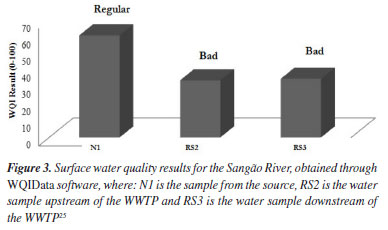
Through the WQI results, it is clear that surface water quality from the Sangão River is impacted from its source onward. Although sample N1 had a 'regular' overall result, analysis by WQIData showed that thermotolerant coliform and turbidity parameters represent particular factors that contribute to lower water quality at the site, with their contribution to the classification based upon data that point to the presence of values over 50% of thermotolerant coliforms and between 10 and 24% turbidity. It may be that management conditions at the site influenced the results, as the N1 samples were collected in a field containing livestock, so contamination by coliform bacteria is likely. Alongside such contamination, livestock activities promote the entry of sediments and ions into the water, due to the impact of cattle passage and an associated reduction in forested areas, which can explain the involvement of the turbidity parameter as a factor impacting water quality at the site, although its result was within the established limits of the CONAMA.23 WQI classifications at points RS2 and RS3 were 'bad'. According to data obtained with WQIData, the factors that contributed to the unsatisfactory quality index in both samples were low dissolved oxygen values and pH, where these parameters contributed between 25-50% weighting to the classification as 'bad'. The low dissolved oxygen values and the high thermotolerant coliform concentrations can be explained due to the volume of sewage that is discharged into the Sangão River, while the low pH can be explained by mining activities during the economic expansion of the municipality. Acute ecotoxicological study with zebrafish embryos In addition to physicochemical parameters, living organisms can be used as bioindicators of environmental quality. In this context, zebrafish have been widely used as an interesting model for monitoring organic pollutants as well as for evaluating certain contaminants in water quality studies.27 Although it was expected that embryos of RS2 and RS3 groups would not survive the entire experimental process due to the poor water conditions already evidenced through physicochemical, microbiological and metal parameters as well as by WQI, we tried to ratify this information and compare with the N1 sample (Figure 4).

The embryos in the control group had a mortality rate within normal limits, while those belonging to the N1 group survived throughout the whole experiment, although a change in coloration of the embryos during the 96-h observation period was observed. An increase in coliform bacteria and in the turbidity values was detected at the source, but no data was found in the literature that could confirm a relation between the observed color alteration and these results. The embryos belonging to RS2 and RS3 groups died within 24 h post-fertilization. Surface water samples RS2 and RS3 had unsatisfactory quality parameters, including pH values of 3.0 and 3.7 and dissolved oxygen concentration of 1.08 and 3 mg L-1, respectively. These factors alone explain the embryo mortality. Recent studies have investigated the quality of surface waters and their relationship with anthropogenic activity. Nascimento et al.44 evaluated the occurrence of anti-inflammatories (diclofenac, paracetamol, ibuprofen and dipyrone) in the Brazilian semi-arid region. All were detected at varying levels of concentration in the São Francisco River. In addition to metabolism and incorrect environmental disposal, a good explanation for their presence was the ease of access to medicines that can be purchased without a prescription.45 In Malaysia, the presence of pharmaceutical contaminants was detected in samples of surface water and also in tap water. Although these quantities are smaller quantities when compared to the concentrations detected in surface and waste water samples. The risks of this exposure are low, but the long-term impacts of this low and continuous exposure cannot be predicted.46 According to the results found, it can be concluded that the contamination of the Sangão River has its main origins in unplanned human activity. Since the economic expansion through the coal industry that contaminated the waters with residues from coal processing making them an unviable environment for the development of aquatic species, to the present day, when domestic sewage and industrial effluents are still dumped. Although part of the municipality already has a portion of its neighborhoods served by the sewage collection network and undergoes treatment before discharging it into the Sangão River, more studies are still needed to evaluate the effectiveness of this treatment in removing pharmaceutical contaminants. Although the Sangão River is not a "living" river, where fishing or recreational activities are carried out, it has its mouth in the Mãe Luzia River and ends up contaminating its waters. One of its main economic activities in the Mãe Luzia River sub-basin is rice cultivation, which may have its production impacted by the condition of the water collected for irrigation.
CONCLUSIONS Through a range of analytical methodologies, six contaminants were detected in the environmental matrices analyzed, belonging to various therapeutic classes, namely antihypertensives (2), stimulants (1), non-steroidal anti-inflammatory drugs (2) and anesthetics (1). Our results support the conclusion that innumerous variables affect the occurrence of such contaminants in environmental compartments and that they are influenced by several factors. Among these are the drug and beverage consumption profile of the population, variable metabolic and excretion rates, disposal practices, drug deterioration kinetics in river water, capacity to aggregate into solid matrices (resulting in sediment retention), occurrence of physicochemical transformations and others, which can impact on their speed of passage in water. Factors independent of the compound exert the same influence on destination and transportation of all such products, such as hydrological characteristics, flow, water temperature, amount of suspended solids and elimination time. The screening techniques used in this study proved to be efficient in detecting the compounds and providing an overview of the conditions of the studied environmental matrices. However, in addition, there are innumerous chemical interactions between both contaminants themselves and between them and their environment, which lack ready quantification or even detection. In addition to pharmaceutical contaminants, it is important to highlight that even with the decrease in carboniferous activity in the municipality of Criciúma, the surface water quality of the Sangão River remains unsatisfactory, especially in relation to points RS2 and RS3, but also at its source, as shown through physicochemical and ecotoxicological studies. In the physicochemical analyses, seventeen parameters showed values that did not comply with current legislation or recommendations, thus demonstrating the lack of surface water quality of the Sangão River, notably pH, which characterizes the acidic water consequent to AMD dumping at the peak of mining activities in the region. Limitations of our study include the relatively small number of sampling points, and the fact that the study was undertaken at a fixed point in the calendar year (season), rather than being a longitudinal evaluation throughout the year. Nonetheless, considering the WQI results, they show that surface water quality of the Sangão River is impacted from its source. Even though the source (N1) sample gave a 'regular' result, it is clear that livestock activity around the source has an impact on quality parameters. Both RS2 and RS3 points were classified as 'bad', due to carboniferous activities and socioeconomic development of the municipality of Criciúma. The ecotoxicological study corroborated the results of the physicochemical and microbiological tests and the WQI analyses, as embryos of RS2 and RS3 groups did not survive the entire experimental period, due to the very poor water quality conditions. Therefore, it is possible to conclude that the water of the Sangão River has negatively impacted the quality of HBA. It is noteworthy that HBA is one of the main sources of water capture for irrigation of rice crops and that viable and effective strategies to improve its water quality must be developed.
ACKNOWLEDGMENTS We acknowledge Fundação de Amparo à Pesquisa e Inovação do Estado de Santa Catarina (FAPESC) for the master's scholarship of Michele D. Freitas, Programa Institucional de Bolsas de Iniciação Científica da Universidade do Extremo Sul Catarinense (PIBIC/UNESC) for the scholarship of Laíse D. S. Rosa and Laboratório de Plantas Medicinais (LaPlaM/UNESC) for financial support.
REFERENCES 1. Chang, C. C.; DiGiovanni, K.; Mei, Y.; Water Environ. Res. 2019, 91, 1129. [Crossref] 2. United Nations Educational, Scientific and Cultural Organization (UNESCO); The United Nations World Water Development Report 201: Valuing Water; UNESCO: Paris, 2021. [Link] accessed in March 2025 3. Al-Hashimi, O.; Hashim, K.; Loffill, E.; Marolt, Č. T.; Nakouti, I.; Faisal, A. A. H.; Al-Ansari, N.; Molecules 2021, 26, 5913. [Crossref] 4. Zahmatkesh, S.; Bokhari, A.; Karimian, M.; Zahra, M. M. A.; Sillanpää, M.; Panchal, H.; Alrubaie, A. J.; Rezakhani, Y.; Environ. Monit. Assess. 2022, 194, 12, 884. [Crossref] 5. Fernández, V. P.; Rocca, L. M.; Tomai, P.; Fanali, S.; Gentili, A.; Anal.Chim. Acta 2017, 983, 9. [Crossref] 6. Richardson, S. D.; Kimura, S. Y.; Environ. Technol. Innovation 2017, 8, 40. [Crossref] 7. Bean, T. G.; Bergstrom, E.; Thomas-Oates, J.; Wolff, A.; Bartl, P.; Eaton, B.; Boall, A.; Environ. Manage. 2016, 58, 707. [Crossref] 8. Klatte, S.; Schaefer, H. C.; Hempel, M.; Sustainable Chem. Pharm. 2017, 5, 61. [Crossref] 9. Ide, A. H.; Osawa, R. A.; Marcante, L. O.; Pereira, J. C.; Azevedo, J. C. R.; Clean 2017, 45, 1700334. [Crossref] 10. Food and Agriculture Organization of the United Nations (FAO); Review of World Water Resources by Country; FAO: Rome, 2003. [Link] accessed in March 2025 11. Agência Nacional de Águas (ANA); Geo Brasil Recursos Hídricos: Componente da SériedeRelatórios sobre o Estado e Perspectivas do Meio Ambiente no Brasil; Ministério do Meio Ambiente/Agência Nacional de Águas: Brasília, 2007. [Link] accessed in March 2025 12. Legislação Estadual de Recursos Hídricos; Lei No. 10949, de 09 de novembro de 1998, Dispõe sobre a Caracterização do Estado em Dez Regiões Hidrográficas; Diário Oficial de Santa Catarina, Florianópolis, Brasil, 1998. [Link] accessed in March 2025 13. Back, A. J.; Bacias Hidrográficas: Classificação e Caracterização Física (comPrograma HidroBacias para Cálculos); Epagri: Florianópolis, 2014. [Link] accessed in March 2025 14. Milioli, G.; Santos, R.; Citadini-Zanette, V.; Mineração de Carvão, Meio Ambiente e Desenvolvimento Sustentável no Sul de Santa Catarina: Uma Abordagem Interdisciplinar, 1ª ed.; Jundiá: Curitiba, 2009. 15. Comitê de Gerenciamento da Hidrográfica do Rio Araranguá, http://www.aguas.sc.gov.br/a-bacia-rio-ararangua/regiao-hidrografica-rio-ararangua, accessed in March 2025. 16. Cassemiro, E.; Rosa, L.; Castro Neto, J. L.; XXIV Encontro Nacional de Engenharia de Produção; Florianópolis, Brasil, 2004. [Link] accessed in March 2025 17. Krebs, A. S. J.; Alexandre, N. J.; 1st Joint World Congress on Groundwater; Fortaleza, Brasil, 2000. [Link] accessed in March 2025 18. Alexandre, N. J.; Revista Tecnologia Ambiente 1999, 5, 35. [Link] accessed in March 2025 19. Bandeira, A. P. F.: Alocação Econômica de Recursos Naturais no Contexto de Bacia Hidrográfica: Aplicação na Bacia do Rio Sangão em Santa Catarina; Tese de Doutorado, Universidade Federal do Rio Grande do Sul, Porto Alegre, Brasil, 2010. [Link] accessed in March 2025 20. Associação Brasileira de Normas Técnicas (ABNT); ABNT-NBR 9898: Preservação e Técnicas deAmostragem de Efluentes LíquidoseCorpos Receptores, Rio de Janeiro, 1987. [Link] accessed in March 2025 21. Jank, L.; Hoff, R. B.; Costa, F. J.; Pizzolatto, T. M.; Int. J. Environ. Anal. 2014, 94, 1013. [Crossref] 22. Arsand, J. B.; Hoff, R. B.; Jank, L.; Dallegarve, A.; Galeazzi, C.; Barreto, F.; Pizzolato, T. M.; Water, Air, Soil Pollut. 2018, 229, 399. [Crossref] 23. Conselho Nacional do Meio Ambiente (CONAMA); Resolução No. 357, de 17 de março de 2005, Dispõe sobre a Classificação dos Corpos de Água e Diretrizes Ambientais para o seu Enquadramento, bem como Estabelece as Condições e Padrões de Lançamento de Efluentes, e dá Outras Providências; Diário Oficial da União (DOU), Brasília, No. 053, de 18/03/2005. [Link] accessed in March 2025 24. Freitas, M. D.: Análise de Contaminantes Emergentes no Município de Criciúma, SC; Dissertação de Mestrado, Universidade do Extremo Sul Catarinense, Criciúma, Brasil, 2018. [Link] accessed in March 2025 25. Boulder Area Sustainability Network (BASIN); National Sanitation Foundation Water Quality Index, 2005 [Link] accessed in March 2025; Posselt, E. L.; Costa, A. B.; Lobo, E. A.; Software IQAData, Registro INPI BR 512015000890-0, 2015. 26. Ferreira, E. C. F.; Almeida, M. C.; Sistema de Cálculo daQualidade da Água (SCQA): Estabelecimento das Equações do Índice de Qualidade das Águas (IQA); Ministério do Meio Ambiente/Secretaria do Meio Ambiente e Desenvolvimento Sustentável de Minas Gerais, 2005. 27. Organisation for Economic Co-operation and Development (OECD); Guidelines for the Testing of Chemicals, Section 2, Test No. 236:Fish Embryo Acute Toxicity (Fet) Test; OECD Publishing: Paris, 2013. [Crossref] 28. Kong, L.; Kadokami, K.; Wang, S.; Duong, H. T.; Chau, H. T. C.; Chemosphere 2015, 122, 125. [Crossref] 29. Alygizakis, N. A.; Gago-Ferrero, P.; Borova, V. L.; Pavlidou, I. H.; Thomaidis, N. S.; Sci. Total Environ. 2016, 541, 1097. [Crossref] 30. Keenaghan, J. B.; Boyes, R. N.; J. Pharmacol. Exp. Ther. 1972, 180, 454. [Link] accessed in March 2025 31. Mandaric, L.; Mor, J. R.; Sabater, S.; Sci. Total Environ. 2018, 613, 763. [Crossref] 32. Szabό, R. K.; Megyeri, Cs.; Illés, E.; Gajda-Schrantz, K.; Mazellier, P.; Dombi, A.; Chemosphere 2011, 84, 1658. [Crossref] 33. Mazaleuskaya, L. L.; Sangkuhl, K.; Thorn, C. F.; Fitzgerald, G. A.; Altman, B.; Klein, T. E.; Pharmacogenet. Genomics 2015, 25, 416. [Crossref] 34. Godoy, A. A.; Kummrow, F.; Pamplin, P. A. Z.; Chemosphere 2015, 138, 281. [Crossref] 35. Batt, A. L.; Kincaid, T. M.; Kostich, M. S.; Lazorchack, J. M.; Olsen, A. R.; Environ. Toxicol.Chem. 2015, 35, 874. [Crossref] 36. Souza, D. N. R.: Ocorrência e Distribuição de Contaminantes Emergentes na Bacia Hidrográfica do Rio Jundiaí - São Paulo; Tese de Doutorado, Universidade Federal de São Carlos, São Carlos, Brasil, 2015. [Link] accessed in March 2025 37. Weiler, J.; Amaral Filho, J. R.; Schneider, I. A. H.; Eng. Sanit. Ambiental 2016, 21, 337. [Crossref] 38. Andrade, L. N.; Rev. Biol. 2010, 5, 16. [Link] accessed in March 2025 39. Machado, P. J. O.; Diagnóstico FísicoAmbiental da Bacia Hidrográfica do CórregoSão Pedro: Um Exercício Acadêmico da Gestão dos Recursos Hídricos, 1ª ed.; Geographica Consultoria, Estudos e Projetos Ambientais Ltda: Ubá, 2010. 40. Fernandes, A. M.; Conceição, F. T.; Sardinha, D. S.; Godoy, L. H.; Pedrazzi, F. J. M.; Geochim. Bras. 2015, 29, 23. [Link] accessed in March 2025 41. Degenhardt, R.; Falavinha, G.; Unoesc & Ciência 2014, 5, 209. [Link] accessed in March 2025 42. Santos, E. P. P.; Veiga, W. A.; Gonçalves, M. R. S.; Thomé, M. P. M.; Sci. Plena 2015, 11, 052401-1. [Crossref] 43. Amaral, L. A.; Nader Filho, A.; Rossi Junior, O. D.; Ferreira, F. L. A.; Barros, L. S. S.; Rev. Saude Publica 2003, 37, 510. [Crossref] 44. Nascimento, R. F.; Carvalho Filho, J. A. A.; Napoleão, D. C.; Ribeiro, B. G.; Cabral, J. J. S. P.; Paiva, L. R.; Water, Air, Soil Pollut. 2023, 234, 255. [Crossref] 45. Martínez-Sales, M.; Garcia-Ximénez, F.; Espinόs, F. J.; J. Environ. Sci. 2015, 33, 254. [Crossref] 46. Hasni, N. A. K.; Annual, Z. F.; Rashid, S. A.; Thahir, S. S. A.; Veloo, Y.; Fang, K. S.; Mazeli, M. I.; Environ. Pollut. 2023, 324, 121095. [Crossref]
Associate Editor handled this article: Cassiana C. Montagner This paper belongs to the Special Issue "Sustainability and Environmental Chemistry". |
On-line version ISSN 1678-7064 Printed version ISSN 0100-4042
Qu�mica Nova
Publica��es da Sociedade Brasileira de Qu�mica
Caixa Postal: 26037
05513-970 S�o Paulo - SP
Tel/Fax: +55.11.3032.2299/+55.11.3814.3602
Free access

